Boatyard | Greyhawk | latest | next | 2007-03 | previous | oldest
GREYHAWK
Frost Heaves in the deck!
Tuesday, March 6, 2007
I think last night was one of the coldest we've had all winter, with the temperature this morning about 5 below Zero F. The temperature today never rose above 10 degrees F.
What happens to a balsa-cored fiberglass laminate structure under these conditions, when the balsa wood is fully saturated with water?
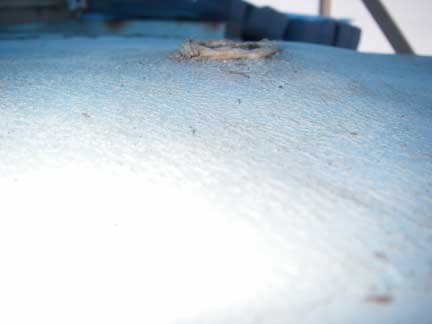
This is where the through deck gland for my hydraulic vang was located, in the cabin roof between the mast and the sea-hood over the companionway hatch. Water got in, saturating the core in the area around the gland. Upon freezing, it has formed a significant dome, and cracked the top fiberglass skin. (The extent of the doming is difficult to photograph, but it is really pretty significant!)
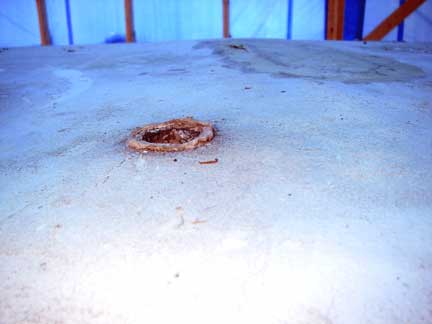
In the background you can see an area where a previous patch to the deck has lifted and cracked.
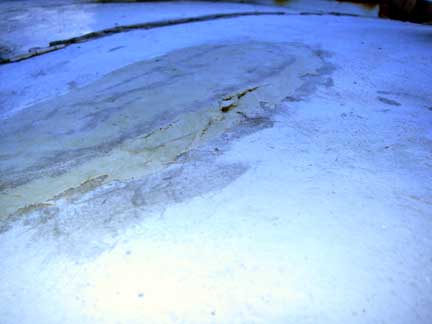
The previous owner of the boat had repaired some areas of damaged core with what appears to be "Great Stuff" foam and then fiberglassed over that. But ultimately that wasn't very effective.
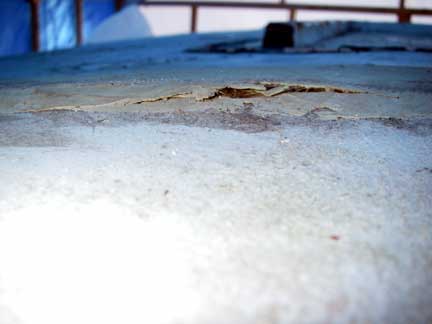
Down below, none of this deformation is noticable; it's mostly the top skin that's a problem.
I'm trying to fit some ventilation hatches in this area between the sea-hood and the mast (working around the hydraulic line, which I suppose could be moved, and the leads for halyards and other lines running from the mast back to winches on the cabin top by the companionway), so all this area will be re-worked one way or another.
Of course, the bigger the holes for the hatches, the less deck that has to be re-cored, right? ;-)
Discussion
I posted the above on the "Plastic Classic Forum", which generated quite a bit of discussion. I refer you to this thread, Wet Core in a Northern Clime. Of particular interest is a link to the August 2005 issue of Professional Boatbuilder magazine, which includes an article on "Wet Balsa Core." Of course, the author's conclusions are a bit controversial...
Autopsy Report
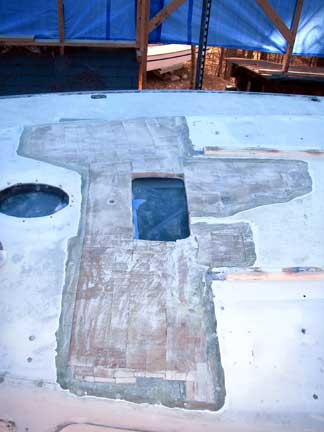
This is a view of the current condition of the area shown above where the deck had domed. I cut out for a new ventilation hatch, and cut away the top skin and removed rotten and/or delaminated core from the surrounding area, prepared the area, and glued in new balsa core. I've started grinding out bevels on the adjacent top skin for laying up a new skin.
To orient yourself, you can see the oval hole in the deck for the mast collar to the left, a rectangular hole for the new ventilation hatch (center), and the rails for the companionway sliding hatch (right).
The deck gland for the hydraulic line (as pictured above) was located right at the forward edge of where the ventilation hatch would end up, so I moved it forward 2 inches (you can see the small hole between the mast hole and the vent hatch hole).
The areas outboard of of the companionway hatch (both sides) are cored with plywood for supporting lots of winches and other hardware for halyards and control lines, etc..). The area between the companionway rails and forward was cored with end-grain balsa. At the transition between the two types of coring, the top and bottom skins come together, so the plywood and balsa are isolated from each other. You can see all this from below:
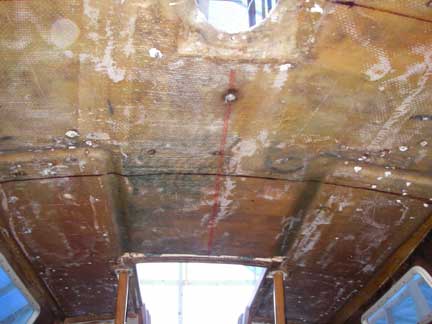
OK, the area forward of the companionway hatch is the area where the frost-heaving occurred. In this area, and off to both sides, the balsa had delaminated from the bottom skin but was still very well adhered to the top skin. The balsa was very wet but not totally black with rot (although it was just starting to decay from the bottom up).
Clearly, this area had been re-cored once before (consistent with the previous owner's report that he had the deck "professionally" recored once already), but they had not done an adequate job of adhereing the new balsa core to the bottom skin... Interestingly, the "scrim" from the balsa was adhered to the bottom skin. Other evidence that this area had been re-cored once before is that the top skin was made of chopped strand mat instead of woven roving as elsewhere, and that there was no molded in non-skid pattern as elsewhere.
In the area between the companionway hatch rails, the balsa wood was totally black with rot -- this area obviously had not been re-cored, as the previous "professional" effort had stopped short of actually unbolting the sea hood over the companionway slider and chasing the rot to its end.
SO, back to the frost-heaves. My hypothesis now is that the wet balsa wood expands horizontally (across grain) when frozen, more so than vertically (along the grain). If the balsa is adhered to both skins, it is constrained and can't go anwhere. If it is delaminated from both skins, then it just crushes itself. It is delaminated from one skin, but still attached to the other, then the attached skin will experience a buckling deformation when the saturated wood freezes.

I think this area cracked because the new top skin the previous owner created over his foamed repair of this area just wasn't very thick, nor well adhered (insufficient overlap) with the adjacent existing skin. The green nature of the filler he used suggests polyester Bondo, so he may have used polyester resins instead of epoxy to make the repair, too.
Working in the Tall Tent in Winter
I really didn't do much epoxy work over the winter, unless the outside temperatures were above 40F (which did happen occaisionally). Then I'ld set up my electric heaters to further warm up the area of the boat where I wanted to work, or rather to keep it "warm" once the sun went down or overnight while the epoxy cured.